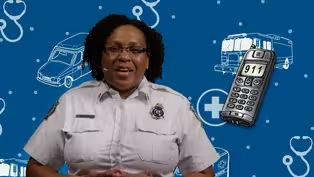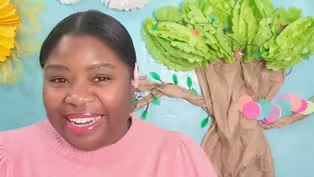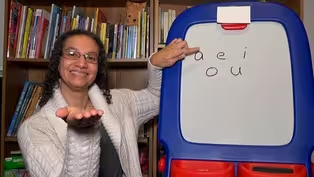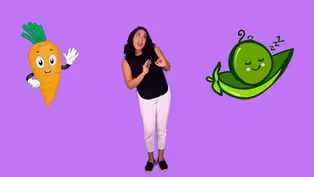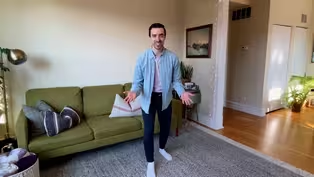
ANIMAL SENSES
Clip: 5/5/2023 | 7m 44sVideo has Audio Description, Closed Captions
Devon Ritter from the Memphis Zoo explores how animals use their five senses to survive.
Devon Ritter from the Memphis Zoo explores how animals use their senses of touch, hearing, sight, and smell to survive in different environments.
See all videos with Audio DescriptionADProblems playing video? | Closed Captioning Feedback
Problems playing video? | Closed Captioning Feedback
Let's Learn is a local public television program presented by THIRTEEN PBS

ANIMAL SENSES
Clip: 5/5/2023 | 7m 44sVideo has Audio Description, Closed Captions
Devon Ritter from the Memphis Zoo explores how animals use their senses of touch, hearing, sight, and smell to survive in different environments.
See all videos with Audio DescriptionADProblems playing video? | Closed Captioning Feedback
How to Watch Let's Learn
Let's Learn is available to stream on pbs.org and the free PBS App, available on iPhone, Apple TV, Android TV, Android smartphones, Amazon Fire TV, Amazon Fire Tablet, Roku, Samsung Smart TV, and Vizio.
Providing Support for PBS.org
Learn Moreabout PBS online sponsorship[bright music] - Hi everyone and welcome to the Memphis Zoo here in Memphis, Tennessee.
My name is Devon and I'm an animal interpreter here at the zoo, and that means I have the very special job of getting to help take care of some of the amazing animals here and getting to introduce them to people just like you.
Now I have a pop quiz for you, everybody.
I want you to look around and tell me what can you see?
Now, can you hear anything?
Can you smell anything?
Can you touch anything?
And can you taste anything?
If you answered any of those questions, great job you just used your five senses.
We have five senses.
Sight, hearing, smell, taste, and touch.
We use our senses to help us learn more about the world around us.
All new information comes from our senses, and just like us animals use their senses to learn as well.
Now our first sense today is sight.
Let's see if we can find an animal friend to help us learn more.
This is our American bald eagle exhibit.
Have you ever heard that someone has eagle eyes?
That just means that someone has incredibly good vision, just like the bald eagle.
They actually have some of the best eyes in the entire animal kingdom.
Eagles are predators, which means that they need to hunt other animals for their food.
They need to have extremely good eyes in order to hunt those predators from above.
Quick everyone, I want you to look to the left.
Now look to the right.
Did you turn your head?
Now I want you to try looking left and right just with your eyes.
Ready?
Left, right.
Were you able to do that?
If you could, you can do something that the eagles can't do.
Eagle eyes are fixed inside of their head and they're unable to look side to side.
So if an eagle needs to look in a new direction, they have to turn their entire head.
Eagles and other birds of prey use their powerful eyes to spot food from high in the sky.
Not only do they have better long distance vision, but eagles can also see in more colors than we can.
That's right.
The human eye can only see so many colors, but some animals can see colors that we can't even imagine because our eyes can't process them.
Eagle eyes may be great, but they have very poor sense of smell.
In fact, most birds can't smell at all.
Let's go meet an animal with a super nose.
Say hello to Toboga, the Madagascar hedgehog tenric.
While he may not have a great sense of vision, he does have excellent smell, and that's because Toboga is another nocturnal animal and he won't be able to rely on his sight to find his food.
Think of your favorite food.
Can you remember how it smells?
What about a really yucky smell?
Gross.
Even if we aren't around the smell, we can sometimes still remember it.
Our senses are so powerful, but how does it work?
Tiny pieces of the environment float into the air and travel up our noses.
Those tiny pieces send signals to our brain to tell us about what we're smelling.
Smell is important because animals need to be able to locate their food and know if it's safe to eat or not.
What's your favorite smell?
Like we learned earlier in the episode, most birds have a poor sense of smell.
Just like my friend Maggie here.
Maggie is a barn owl and she's nocturnal, which means that she's usually going to be awake during the night.
But Maggie can't rely on her nose to find her food and it can be really difficult to see in the dark.
So what sense do you think Maggie uses to find her food?
Can you guess what it is?
It's her hearing.
Yeah.
It may not seem like Maggie has ears, but I promise you she does.
Her ears are small holes on the side of her head that are covered by feathers, but they're extremely powerful.
For owls like Maggie, one ear is higher than the other, which makes it easier to pinpoint exactly where her food is.
That is extremely helpful when owls are hunting for mice and other small animals in the dark.
Our ears are an important sense, but we can damage them if we aren't careful.
It's important to avoid loud music and other noises that could potentially damage our hearing.
As we get older, we can lose our sense of hearing.
So it's important to help protect our ears while we're young.
Now, what was our next sense again?
Hmm.
Oh, that's right.
It's touch.
Touch is one of our most important senses because it helps us to navigate the world around us.
Animals can use their sense of touch in many ways, but one very special way is with whiskers.
Now, do you have a cat or dog at home?
They have whiskers, just like the big cats behind me.
Whiskers are very sensitive.
Light touches can tell an animal if they're close to something, they're so sensitive that they can even tell if there's a slight change in the air.
This helps them to hunt and navigate small places.
But whiskers aren't the only way animals use their sense of touch.
Animals can use their sense of touch all over their bodies, and some animals have special body parts that help them to feel like the lateral lines of fish.
That's a special set of scales that help fish to detect tiny changes in the water.
Insects have antenna which can help them sense objects around them as well.
Next, let's meet a surprising animal when it comes to learning about taste.
An animal here at the aquarium has an amazing sense of taste.
Can you guess who it is?
It's the catfish.
Now everyone stick out your tongue.
Ah.
Our taste buds cover our tongue and they help us to pick up different chemicals to taste, but catfish actually have taste buds all over their bodies.
Catfish live in dark, murky water, so having a strong sense of taste means they can find even tiny amounts of foods.
Catfish aren't the only animals with a surprising sense of taste.
Tarantulas use their feet to taste the world around them.
While tasting may look different in different animals, it's just one more amazing way that animals can learn about their environment.
What are your favorite flavors?
I like salty food.
So far today we've learned that even if an animal has a sense that isn't very powerful, they make up for it with their other senses.
Some animals even have extra senses that we as humans don't have, like Monty here.
Monty, like other snakes, has a special organ at the top of her mouth that can actually help her to basically smell the air around her.
Isn't that incredible?
Now let's go meet some more animals with extra special senses.
Some animals, like bats can use at echo location to hunt their food.
They make a special sound that bounces off their food and tells the bat where it is.
Others like birds can sense magnets in the Earth to help them find their way.
And some animals like snakes can even see an infrared and ultraviolet light, which humans can't see unless we use special tools.
There may even be more senses that we don't know about.
Just like the animals we met today, we use our senses to learn more about the world around us.
We use our eyes to see, our ears to hear, our nose to smell, our tongue to taste, and our hands and skin to feel things.
Remember, we may not all have the same senses, but that's okay.
We all use our senses in one way or another to learn more about the world around us.
I have a question for you, my friends.
What will you use your senses for today?
I think I'm going to enjoy seeing all of the amazing animals here at the zoo.
Thank you so much for learning with me.
Have a nice day everyone.
Video has Audio Description, Closed Captions
Clip: 5/5/2023 | 53s | A 9-1-1- emergency operator describes how she helps people. (53s)
Video has Audio Description, Closed Captions
Clip: 5/5/2023 | 1m 3s | Camila plays "Für Elise." (1m 3s)
Video has Audio Description, Closed Captions
Clip: 5/5/2023 | 7m 46s | Darlene Thomas reads HOW TO WAKE UP PIGGY by Pingjoing Xu, illustrated by Ying Haung. (7m 46s)
Video has Audio Description, Closed Captions
Clip: 5/5/2023 | 9m 29s | Anna Scretching-Cole reviews long vowel sounds. (9m 29s)
Video has Audio Description, Closed Captions
Clip: 5/5/2023 | 10m 2s | Priya Chandrashaker uses her sense of touch to identify the shape of household objects. (10m 2s)
Video has Audio Description, Closed Captions
Clip: 5/5/2023 | 2m 55s | Flor Bromley and Paul Saul sing “Peas and Carrots.” (2m 55s)
Video has Audio Description, Closed Captions
Clip: 5/5/2023 | 2m 37s | Aaron Umsted uses his senses of sight, touch, and hearing to dance. (2m 37s)
USING SENSES TO PRACTICE MINDFULNESS
Video has Audio Description, Closed Captions
Clip: 5/5/2023 | 9m 49s | Brenda Salazar introduces Spanish words while using her senses to practice mindfulness. (9m 49s)
Providing Support for PBS.org
Learn Moreabout PBS online sponsorshipSupport for PBS provided by:
Let's Learn is a local public television program presented by THIRTEEN PBS
